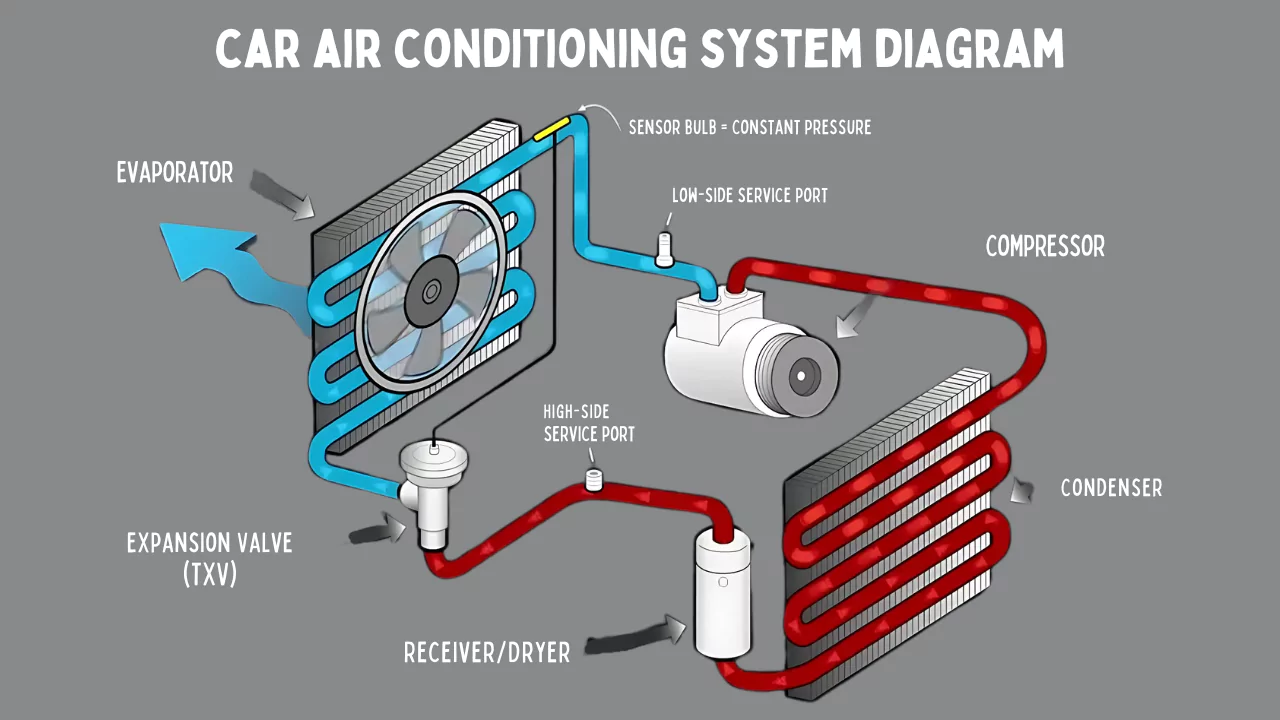Automobile engines are designed with an air conditioning system to keep users satisfied by cooling the car interior in hot weather. Modern vehicles also control cold weather by using heat from the engine.
The air conditioning system was first introduced by the Packard Motor Company in the United States in 1939, and now it is a common feature in all vehicles for the convenience of humans.
What is a Car air conditioning system?
An Car air conditioning system is a set of components that work together to emit coolness into a car’s interior. It functions similarly to the AC systems used in homes and offices.
The system does not actually create cold air but rather cools the surroundings to provide comfort, using components such as a compressor, condenser, and evaporator.

How Does Car AC Work?
The air conditioning system in a car works by manipulating refrigerant between a liquid and a gaseous state. As the refrigerant changes states, it absorbs heat and humidity from the vehicle and allows the system to give off cool, dry air.
To change the refrigerant between a liquid and a gaseous state, the air conditioning system works to control pressure and temperature.
AC System Refrigerants
In the past, automotive air conditioning systems used R-12 as the refrigerant. R-12 (aka Freon) is a very effective CFC-based (chlorofluorocarbon) refrigerant that is not flammable and not poisonous to humans.
During the late 1980s, scientists discovered that widespread use of R-12 was damaging the earth’s ozone layer.
Manufacturers transitioned to R-134a in the mid-1990s. R-134a is an HFC-based (hydrofluorocarbon) refrigerant that does not have the ozone-destroying properties of Freon.
The newest refrigerant is R-1234yf, which produces fewer greenhouse gases. Europe requires the use of R-1234yf, and it will likely become the new standard in the United States.
How to recharge a car AC? If the AC system of a vehicle stops working efficiently, a technician can recharge the system with a new refrigerant.
Car AC System Parts
Below are the components of the air conditioning system in an car:

#1. Compressor.
The compressor is the core, primary part of every A/C system. They control temperature output with an electrically operated clutch.
This clutch turns on and off whenever you change the temperature or if the HVAC module senses it has reached the desired temperature. If the ambient air temperature drops below the programmed value, the compressor clutch may not engage.
Signs of a Worn A/C Compressor
- Erratic or failing A/C operation
- Oil or refrigerant leaks (a professional can use special dyes to spot a refrigerant leak)
- Strange noises coming from under the hood while the A/C is on
#2. Condenser.
Consider the A/C condenser the master of turning hot refrigerant gasses into liquid. The condenser is mounted at the front of most vehicles, usually in front of the radiator. Outside ambient air passes through the condenser, condensing and cooling the hot refrigerant gas into a cool liquid refrigerant.
Signs of a Worn A/C Condenser
- Leaks
- Clogged, corroded, or damaged fins or tubes
- Poor air conditioning performance
#3. Receiver/Dryer.
The receiver/drier is found on vehicles with a thermal expansion valve. It’s the safety net responsible for helping trap and prevent harmful debris and moisture from reaching the compressor and other vital A/C parts.
The receiver/drier should be replaced anytime the A/C system is opened for repair or if a technician determines moisture or debris has damaged your receiver/dryer performance.
Symptoms of a Worn Receiver/Drier:
- Moisture on glass and/or inability of defroster to remove moisture from glass and windows
- Poor air conditioner performance
#4. Accumulator.
An accumulator is similar to a receiver/drier but is only on vehicles with an orifice tube. If you have an accumulator, you do not have a thermal expansion valve.
The accumulator:
- Monitors and controls the amount of refrigerant that enters the evaporator
- Stores excess refrigerant so that it cannot enter and damage the compressor
- Filters debris and removes moisture from the A/C System
You will need to replace the accumulator if the A/C system is opened for repair or if a technician determines moisture or debris has damaged your accumulator’s performance.
#5. Thermal Expansion Valve or Orifice Tube.
The orifice tube or thermal expansion valve is located between the condenser and the evaporator.
It constantly monitors the pressure and temperature of your A/C system to determine the exact amount of refrigerant that can safely enter your evaporator. If too much or too little refrigerant enters the evaporator, you could have a big problem.
An orifice tube may also contain a fine mesh screen to block contaminants from the rest of the system.
Signs You May Need a New Orifice Tube or Thermal Expansion Valve:
- A technician has determined it’s dirty or clogged
- Poor A/C system performance
#6. Evaporator.
The evaporator is located behind your dash and is responsible for cooling cabin air and removing moisture. Low-pressure refrigerant traveling through the evaporator cools it.
This allows the evaporator to absorb heat from the cabin air, dropping the temperature of the air blowing out of the vents. If cold, refreshing air hits your face, the evaporator is working like a champ.
Symptoms of a Worn Evaporator:
- Poor A/C system performance
#7. Compressor Clutch.
Before the compressor turns on, a special electromagnetic clutch (the compressor clutch) engages and disengages the compressor cycle. The compressor clutch engages the compressor, turning it on or off when commanded.
Symptoms of a Failing Compressor Clutch:
- Poor A/C performance
- Inability to turn the A/C on or off
- Clutch will not engage
#8. Clutch Cycling Switch.
The clutch cycling switch cycles the compressor according to the pressure in the accumulator. This action helps to prevent the evaporator from freezing.
Although most cars can blow air at temperatures as low as 60 degrees, the temperatures inside the evaporator core can get cold enough to freeze the entire core completely.
The clutch cycle’s job is to ensure the evaporator doesn’t reach the point of glacier temperatures.
Symptoms of a Failing Clutch Cycling Switch:
- Evaporator freezing up
- Evaportor does not get cold enough
#9. Refrigerant.
Refrigerant (often referred to by the DuPont trade name Freon) is a specially formulated cooling agent that can transform from a liquid to a gas and back again. It absorbs and releases heat, ultimately leaving cool air behind.
Different devices, such as your home refrigerator, home A/C system, or vehicle, may use different refrigerants. They may or may not be the same.
What Are the Different Types of Car Refrigerant?
The three common car refrigerants are R-12, R-134a, and R-1234yf. Different refrigerant types require different charging hoses, so check which one your vehicle is it in earlier models.
- R-12: R-12 is the original chlorofluorocarbon (CFC) Freon used in car A/C systems until the mid-1990s. It was banned after the EPA discovered that it depletes the ozone layer. Vehicles manufactured pre-1995 often use R-12, but you can retrofit them with an R-134a system.
- R-134a (HFC-134a): Your vehicle likely uses R-134a (also called HFC-134a). This refrigerant surfaced to replace R-12 once its environmental dangers were discovered. While R-134a is safer than R-12, and most vehicles use it, it’s still not the safest option for the ozone. Manufacturers have recently phased it out.
- R-1234yf (HFO-1234yf): To replace the phased-out R-134a, manufacturers created R-1234yf (also called HFO-1234yf), a hydrofluoric-olefin refrigerant. R-1234yf is an even more environmentally friendly refrigerant. It should be in cars manufactured after 2021, though you may find it in earlier models.
Symptoms of a Bad Car AC System
Below are the symptoms and causes of an Car air conditioning system:
Weak Airflow:
Over time, drivers experience weak airflow in their cars, which is caused by a lot of factors. This symptom could damage or cause fatal damage to the A/C system. Below are the causes of weak airflow:
- A fried ventilation fan is a cause of weak airflow. This is when the fan in the system is not blowing, causing air to not flow effectively.
- There could be mold accumulating in the evaporator core from residual moisture.
- Weak airflow in the car air conditioning system is caused by hose loss.
- The core case that houses the blower has seals that can open up. This will also diminish the airflow in the system.
The functionality of the A/C system is reduced.
Your A/C will sometimes lack precious coolness, which could be caused by several reasons. When the symptom occurs, it should be fixed as soon as possible, or else big damage will be caused to the system. Below are the causes of these symptoms.
- A failed blower motor or blower resistor.
- If the tube or refrigerant charging hose is expanded by a clog,.
- When electrical parts like a fuse, switch, relay, solenoid, or control module fail, symptoms occur.
- A damaged or failing condenser or evaporator is also a major cause.
- Leak vacuum
- A failed compressor or compressor clutch can also cause a weak system.
- A freon leak is caused by a failed o-ring seal or component.
The A/C system cools at first and then gets warm in no time.
This is caused by various issues, but you should inspect and fix them to keep the system normal. A DIYer won’t be able to fix the issue; otherwise, the whole system will be scattered. Below are the common causes of such a problem:
- A clogged expansion valve is a major cause of this problem.
- A faulty compressor clutch is also a major cause of such an issue.
- The fuse that powers the A/C system can shoot out and cause the system to stop working.
Receiving gym locker odor from the A/C vent:
Instead of experiencing cool air from the vent, the order from the gym locker takes charge, which is not cool. Below are the common causes of the issue:
- A moldy evaporator case is a common cause.
- It can also be caused by dirty and old cabin filters.
Common AC System Failures
Because automotive air conditioning systems operate under pressure, they need to remain completely sealed from the surrounding environment. Anything that allows refrigerant to escape or contaminants to enter can cause a failure.
If a leak is present in any component, simply recharging the system with new refrigerant will be at best a temporary fix. Identify the leak, replace the faulty component and then evacuate and recharge the system.
Not only will a system leak stop the AC system from cooling, but it can also damage the compressor.
The compressor can overheat and damage itself by trying to run with too little refrigerant in the system. Compressors generally are not serviceable and are an expensive item to replace.
To operate correctly, the AC condenser needs a steady flow of air through its fins. Road debris and dirt may reduce airflow, causing system malfunction.
The condenser is mounted directly behind the vehicle grill, leaving it somewhat exposed and at risk for partial blockage.